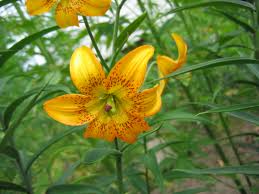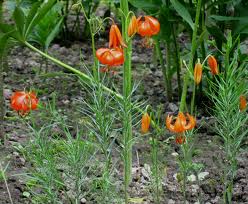Lilium
|
This group consists of 80 to 90 perennial bulbs, of which most are hardy. True Lilies come from the group, Lilium. Many plants that have Lily as part of their common name are not true Lilies (i.e. Daylily comes from the group, Hermerocallis). Lilies come mainly from the temperate woodlands of the Northern Hemisphere; therefore, they do not like dry heat.They are usually found growing near shrubs and other plants that shade their roots and keep the bulbs cool and moist. Lilies come in a huge variety of colors, shapes and sizes and can be grown both indoors and out. Some have strict soil requirements while others can be grown in ordinary garden soil. Lilies bloom from mid-spring to early fall depending upon the variety. Most Lilies are excellent cut flowers, each blossom often living for up to 8 days. However, when cutting for indoors, make sure to leave as much of the stem and leaves on the plant as possible in order to store food for the next year's flowers. The types of Lilies include the Asiatic hybrids, Oriental hybrids, Martagon hybrids, Candidum hybrids, American hybrids, Longiflorum hybrids, Trumpet hybrids and the wild species.
Asiatic hybrids were derived from a species that originated in Asia. They bloom in early summer, usually flowering for over a month. Their 4- to 6-inch blossoms, which may face up, out, or down, come in shades of red, orange, yellow, pink, lavender, and white. The plants produce compact growth and range from 2 to 5 feet high. They are great for growing in containers and for cutting and are quite disease resistant. Martagon hybrids are derived from L. Martagon (Martagon Lily; Turk's-Cap Lily). They produce their 2- to 4-inch, nodding flowers in early summer. The flowers come in white, yellow, orange, tangerine, mahogany, brown, lavender, or lilac. Martagon hybrids can reach heights ranging from 3 to 6 feet. Candidum hybrids, derived from L. candidum (Madonna Lily or White Lily), produce their fragrant, 4- to 5-inch flowers in early summer. These plants grow from 3 to 4 feet high. American hybrids are derived from native North American Lilies. They grow from 4 to 8 feet in height and produce their 4- to 6-inch flowers in late spring and early summer. Longiflorum hybrids, derived from the popular L. longiflorum (Easter Lily), can be grown from zones 6 to 11 and with protection, zone 5. These hybrids produce aromatic, white, trumpet-shaped flowers. They grow to about 3 feet high and bloom in mid-summer, although they can be forced to bloom indoors for Easter. Trumpet hybrids were derived from Asiatic species. These Lilies grow from 4 to 6 feet high and produce large, 6- to 10-inch flowers in the summer. Oriental hybrids were mostly derived from L. auratum (see wild species below) and L. speciosum. These beautiful plants range in height from 2 to 8 feet. They produce huge flowers up to a foot across. The pleasantly scented blossoms are borne in late summer. They are bowl-shaped with recurving petals. They come in white, pinks, deep reds, and bicolors. These are great for growing in containers, but may need staking because of their size. The Wild species are natives to North America, Europe, and Asia. Wild species are the kind that still occur growing in the wild and which haven't yet been affected by hybridization. L. auratum (Gold-banded Lily) is one of the most beautiful of the wild species. It bears up to thirty-five, star-shaped, highly aromatic flowers per stem, usually in August and sometimes in September. The large flowers can reach a diameter of 10 to 12 inches. They are white with a golden-yellow stripe down the center and numerous tiny red speckles. L. lancifolium (Tiger Lily) is a well-known native of Japan and China. Its flowers are borne in late summer atop 4- to 5-foot stems. They consist of reflexed, bright red or orange-red petals covered with little speckles. An interesting characteristic of this flower is that bulbils appear in the leaf axils. This Lily has a played an important part in the development of the Asiatic hybrids and other lilies. Pot CultivationLilies are suitable for growing in beds, borders, meadows, woodlands, containers and as houseplants. They should be in a location that receives full sun or light shade. When purchasing your bulbs, look for those packed in moist peat moss in ventilated plastic bags. Plant them immediately after purchasing. Lilies can be planted in the spring or fall, although autumn in preferred, except for Madonna Lilies, which should be planted somewhat earlier in late summer to early fall. Plant the bulbs in well-drained, loose, friable soil that contains plenty of decayed organic matter. You can improve heavy clay soil or very sandy soil by adding compost, peat moss, or leaf mold. The depth at which you plant your bulbs depends upon the variety. Some Lilies only produce roots from the base of the bulb while others produce them from along the base of the stem as well as from the base of the bulb. Generally, they should be planted 8 inches deep from the bulb bases with their noses covered with at least 2 inches of soil. However, the Madonna Lily (L. candidum) and its hybrids are an exception; they should be planted with just an inch of soil over their noses. Asiatic and Martagon hybrids should be planted 2 to 10 inches underground (because they also form roots along their stem). You should space your bulbs at least a foot apart, especially large varieties. You may need to stake your plants in windy locations. Lilies should be watered regularly while growing actively. A thorough soaking to a depth of 6 to 8 inches once a week is better than frequent, shallow waterings. To help conserve moisture, it is beneficial to mulch your plants with leaf mold, peat moss, or compost. This also helps to provide the cool soil, which Lilies prefer. It is also wise to mulch the ground heavily in the fall in order to protect the bulbs from alternate thawing and freezing spells. Lilies are especially susceptible to Lily mosaic, which is usually transmitted by aphids. Purchase healthy bulbs from reputable suppliers to help prevent this virus. Deer and rabbits are also troublesome to Lilies. When you use Lilies as cut flowers, be sure to leave as much stem and foliage on the plant to allow it to store food for next year's growth. You might want to clip the pollen off the anthers to keep it from staining clothing and tablecloths. PropagationSeeds can be sown in late spring or early summer, but usually take four to six years to bloom. They can be sown in containers or directly in cool, moist soil outside where there is shelter from harsh midday sun. They can be grown in regular garden soil to which a little leaf mold or peat moss has been mixed in. Scatter the seeds thinly in shallow drills just over an inch deep. Cover the seeds with about an inch of fine soil. Small bulbils, which form along the stems of some Lilies, will sprout in the garden. These bulbils should be removed just after the blooms fade. Plant them an inch apart in sandy peat and leaf mold. Scales from the bulb can also be used to increase your plants. Remove a few of the loose, outer scales and bury the bases in coarse sand, which is in a shallow pan. This may be done in March, October, or November. Cover the pan with glass and place in a cool greenhouse. Eventually, bulblets will form and can be planted as described above. The groups of bulbs can also be lifted and divided in the fall, once the stems and leaves have died. However, this shouldn't be done more than every third or fourth year.
VARIETIES
|






